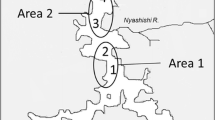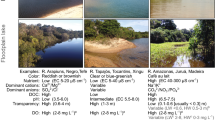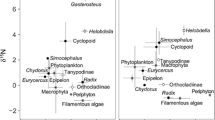Abstract
Stoichiometry theory states that the elemental composition of individual organisms is a taxon-dependent trait, and that organisms maintain relatively constant body nutrient composition, independent of food nutrient content or ingestion rate. Some recent studies have pointed out that assuming a strict homeostasis in fish is an over-simplification, so that nutrient ratios in fish bodies may not be as constant as previously thought. In this study, our aims were (a) to assess the overall nutrient composition of roach, (b) to reveal any significant differences in elemental composition of roach between populations from different lakes and (c) to relate these potential differences to environmental parameters and fish condition. The mean elemental composition of roach (whole fish) was 45.0 ± 5.3 % carbon (C), 10.2 ± 0.8 % nitrogen (N), and 2.4 ± 0.5 % phosphorus (P), while their molar C/N/P ratio was approximately 50:10:1. The elemental composition of roach was not as constant as homeostatic stoichiometry models would predict. Significant differences were found in the carbon, nitrogen, and phosphorus contents of fish sampled from different lakes. Productivity of lakes (expressed as chlorophyll-a) was positively correlated with %C, C/N, C/P, and N/P ratios, and negatively correlated with %N and %P. In turn, mean lake temperature was negatively correlated with %C and C/N ratio, but not with other nutrients or nutrient ratios. Condition factor was negatively related to the %C of fish, but it did not correlate significantly with %N, %P, or nutrient ratios. Our results on intraspecific nutrient variation illustrate the potential differences between populations and emphasize the importance of lake-specific approaches.



Similar content being viewed by others
References
Attayde JL, Hansson LA (2001) Fish-mediated nutrient recycling and the trophic cascade in lakes. Can J Fish Aquat Sci 58:1924–1931
Barnes C, Sweeting CJ, Jennings S, Barry JT, Polunin NVC (2007) Effect of temperature and ration size on carbon and nitrogen stable isotope trophic fractionation. Funct Ecol 21:356–362
Boros G, Tátrai I, Nagy SA (2009a) Using high-pressure teflon bomb digestion in phosphorus determination of aquatic animals. Ann Limnol Int J Lim 45:55–58
Boros G, Tátrai I, György ÁI, Vári Á, Nagy SA (2009b) Changes in internal phosphorus loading and fish population as possible causes of water quality decline in a shallow, biomanipulated lake. Int Rev Hydrobiol 94:326–337
Brabrand A, Faafeng BA, Nilssen JPM (1990) Relative importance of phosphorus supply to phytoplankton production: fish excretion versus external loading. Can J Aquat Sci 47:364–372
Chidami S, Amyot M (2008) Fish decomposition in boreal lakes and biogeochemical implications. Limnol Oceanogr 53:1988–1996
Dickman EM, Newell JM, González MJ, Vanni MJ (2008) Light, nutrients, and food-chain length constrain planktonic energy transfer efficiency across multiple trophic levels. PNAS 105:18408–18412
Fagan K-A, Koops MA, Arts MT, Power M (2011) Assessing the utility of C:N ratios for predicting lipid content of fishes. Can J Fish Aquat Sci 68:374–385
Gido KB (2002) Interspecific comparisons and the potential importance of nutrient excretion by benthic fishes in a large reservoir. Trans Am Fish Soc 131:260–270
Glaholt SP, Vanni MJ (2005) Ecological responses to simulated benthic-derived nutrient subsidies mediated by omnivorous fish. Freshwater Biol 50:1864–1881
Gliwicz ZM, Rutkowska AE, Wojciechowska J (2000) Daphnia populations in three interconnected lakes with roach as the principal planktivore. J Plankt Res 22:1539–1557
Griffiths D (2006) The direct contribution of fish to lake phosphorus cycles. Ecol Freshw Fish 15:86–95
Helminen H, Sarvala J (1997) Responses of Lake Pyhäjäjrvi (southwestern Finland) to variable recruitment of the major planktivorous fish, vendace (Coregonus albula). Can J Fish Aquat Sci 54:32–40
Hendrixson HA, Sterner RW, Kay AD (2007) Elemental stoichiometry of freshwater fishes in relation to phylogeny, allometry and ecology. J Fish Biol 70:121–140
Horppila J, Kairesalo T (1990) A fading recovery: the role of roach (Rutilus rutilus L.) in maintaining high phytoplankton productivity and biomass in Lake Vesijärvi, southern Finland. Hydrobiologia 200(201):153–165
Horppila J, Kairesalo T (1992) Impacts of bleak (Alburnus alburnus) and roach (Rutilus rutilus) on water quality, sedimentation and internal nutrient loading. Hydrobiologia 243(244):323–331
Horppila J, Peltonen H (1994) The fate of a roach Rutilus rutilus stock under an extremely strong fishing pressure and its predicted development after the cessation of mass removal. J Fish Biol 45:777–786
Istvánovics V, Clement A, Somlyódy L, Specziár A, Tóth LG, Padisák J (2007) Updating water quality targets for shallow Lake Balaton (Hungary), recovering from eutrophication. Hydrobiologia 581:305–318
Jeppesen E, Søndergaard M, Jensen JP, Mortensen E, Hansen A-M, Jørgensen T (1998) Cascading trophic interactions from fish to bacteria and nutrients after reduced sewage loading: an 18-year study of a shallow hypertrophic lake. Ecosystems 1:250–267
Johnson CR, Luecke C, Whalen SC, Evans MA (2010) Direct and indirect effects of fish on pelagic nitrogen and phosphorus availability in oligotrophic Arctic Alaskan lakes. Can J Fish Aquat Sci 67:1635–1648
Kitchell JF, Koonce JF, Tennis PS (1975) Phosphorus flux through fishes. Verh Int Verein Limnol 19:2478–2484
Kraft CE (1992) Estimates of phosphorus and nitrogen cycling by fish using a bioenergetics approach. Can J Fish Aquat Sci 49:2596–2604
Kraft CE (1993) Phosphorus regeneration by Lake Michigan alewives in the mid-1970s. Trans Am Fish Soc 122:749–755
Leppä M, Hämäläinen H, Karjalainen J (2003) The response of benthic macroinvertebrates to whole-lake biomanipulation. Hydrobiologia 498:97–105
McIntyre PB, Flecker AS, Vanni MJ, Hood JM, Taylor BW, Thomas SA (2008) Fish distributions and nutrient cycling in streams: can fish create biogeochemical hotspots? Ecology 89:2335–2346
Mehner T, Ihlau J, Dörner H, Hölker F (2005) Can feeding of fish on terrestrial insects subsidize the nutrient pool of lakes? Limnol Oceanogr 50:2022–2031
Mehner T, Ihlau J, Dörner H, Hupfer M, Hölker F (2007) The role of insectivorous fish in fostering the allochtonous subsidy of lakes. Limnol Oceanogr 52:2718–2721
Meriläinen JJ, Hynynen J, Palomäki A, Mäntykoski K, Witick A (2003) Environmental history of an urban lake: a paleolimnological study of Lake Jyväsjärvi. Finland J Paleolimnol 30:387–406
Nakashima BS, Legett WC (1980) The role of fishes in the regulation of phosphorus availability in lakes. Can J Fish Aquat Sci 37:1540–1549
Nash RDM, Valencia AH, Geffen AJ (2006) The origin of Fulton’s condition factor—setting the record straight. Fisheries 31:236–238
Penczak T, Tátrai I (1985) Contribution of bream, Abramis brama (L.), to the nutrient dynamics of Lake Balaton. Hydrobiologia 126:59–64
Persson A (1997) Phosphorus release by fish in relation to external and internal load in a eutrophic lake. Limnol Oceanogr 42:577–583
Pilati A, Vanni MJ (2007) Ontogeny, diet shifts, and nutrient stoichiometry in fish. Oikos 116:1663–1674
Premke K, Fischer P, Hempel M, Rothhaupt KO (2010) Ecological studies on the decomposition rate of fish carcasses by benthic organisms in the littoral zone of Lake Constance, Germany. Ann Limnol Int J Limnol 46:157–168
Schaus MH, Vanni MJ, Wissing TE, Bremigan MT, Garvey JE, Stein RA (1997) Nitrogen and phosphorus excretion by detritivorous gizzard shad in a reservoir ecosystem. Limnol Oceanogr 42:1386–1397
Scheffer M (1998) Ecology of shallow lakes. Chapman & Hall, UK
Sereda JM, Hudson JJ (2010) Comparative estimate of P fluxes in lakes: a comment on “Fish decomposition in boreal lakes and biogeochemical implications” by Chidami and Amyot (2008). Limnol Oceanogr 55:463–465
Sereda JM, Hudson JJ, Taylor WD, Demers E (2008) Fish as sources and sinks of nutrients in lakes. Freshwater Biol 53:278–289
Shimeno S, Shikata T, Hosokawa H, Masumoto T, Kheyyali D (1997) Metabolic response to feeding rates in common carp, Cyprinus carpio. Aquaculture 151:371–377
Søndergaard M, Jensen JP, Jeppesen E (2001) Retention and internal loading of phosphorus in shallow, eutrophic lakes. The Scientific World 1:427–442 (electronic)
Søndergaard M, Jeppesen E, Lauridsen TL, Skov C, Van Nes EH, Roijackers R, Lammens E, Portielje R (2007) Lake restoration: successes, failures and long-term effects. J Appl Ecol 44:1095–1105
Sterner RW, Elser JJ (2002) Ecological stoichiometry: the biology of elements from molecules to the biosphere. Princeton University Press, Princeton
Sterner RW, George NB (2000) Carbon, nitrogen and phosphorus stoichiometry of cyprinid fishes. Ecology 81:127–140
Syväranta J, Jones RI (2008) Changes in feeding niche widths of perch and roach following biomanipulation, revealed by stable isotope analysis. Freshwater Biol 53:425–434
Tanner DK, Brazner JC, Brady VJ (2000) Factors influencing carbon, nitrogen, and phosphorus content of fish from a Lake Superior coastal wetland. Can J Fish Aquat Sci 57:1243–1251
Tátrai I, Mátyás K, Korponai J, Szabó G, Pomogyi P, Héri J (2005) Response of nutrients, plankton communities and macrophytes to fish manipulation in a small eutrophic wetland lake. Int Rev Hydrobiol 90:511–522
Tátrai I, Istvánovics V, Tóth LG, Kóbor I (2008) Management measures and long-term water quality changes in Lake Balaton (Hungary). Fund Appl Limnol 172:1–11
Threlkeld ST (1988) Planktivory and planktivore biomass effects on zooplankton, phytoplankton, and the trophic cascade. Limnol Oceanogr 33:1362–1375
Tolonen KT, Karjalainen J, Staff S, Leppä M (2000) Individual and population-level food consumption by cyprinids and percids in a mesotrophic lake. Ecol Freshw Fish 9:153–162
Vanni MJ (2002) Nutrient cycling by animals in freshwater ecosystems. Ann Rev Ecol Syst 33:341–370
Vanni MJ, Layne CD (1997) Nutrient recycling and herbivory as mechanisms in the “top-down” effect of fish on algae in lakes. Ecology 78:21–40
Vanni MJ, Bowling AM, Dickman EM, Hale RS, Higgins KA, Horgan MJ, Knoll LB, Renwick WH, Stein RA (2006) Nutrient cycling by fish supports relatively more lake primary production as ecosystem productivity increases. Ecology 87:1696–1709
Vrede T, Drakare S, Eklöv P, Hein A, Liess A, Olsson J, Persson J, Quevedo M, Stabo R, Svenbäck R (2011) Ecological stoichiometry of Eurasian perch—intraspecific variation due to size, habitat and diet. Oikos 120:886–896
Winfield IJ, Nelson JS (1991) Cyprinid fishes—systematics, biology and exploitation. Chapman & Hall, UK
Wurtsbaugh WA (2007) Nutrient cycling and transport by fish and terrestrial insect nutrient subsidies to lakes. Limnol Oceanogr 52:2715–2718
Acknowledgments
We thank the support of the University of Jyväskylä (Finland), the EU REFRESH project, the Danish Lake Restoration Centre-CLEAR (a Villum Kann Rasmussen Centre of Excellence project), and the Hungarian National Research Fund (OTKA-T048758). Research was conducted in international collaboration, supported by the FUNCDYN program of the European Science Foundation. Data for Lake Tisza were provided by Middle-Tisza District Environment and Water Management Authority. Special thanks to Michael J. Vanni and the members of his lab, for their help in improving this paper. The authors are grateful for the helpful comments of the reviewers and the contribution of all researchers, technicians, and students who took part in this project.
Author information
Authors and Affiliations
Corresponding author
Additional information
This paper is dedicated to the memory of István Tátrai, a great researcher and friend, who passed away before publication.
Handling Editor: Thomas Mehner.
Rights and permissions
About this article
Cite this article
Boros, G., Jyväsjärvi, J., Takács, P. et al. Between-lake variation in the elemental composition of roach (Rutilus rutilus L.). Aquat Ecol 46, 385–394 (2012). https://doi.org/10.1007/s10452-012-9402-3
Received:
Accepted:
Published:
Issue Date:
DOI: https://doi.org/10.1007/s10452-012-9402-3




